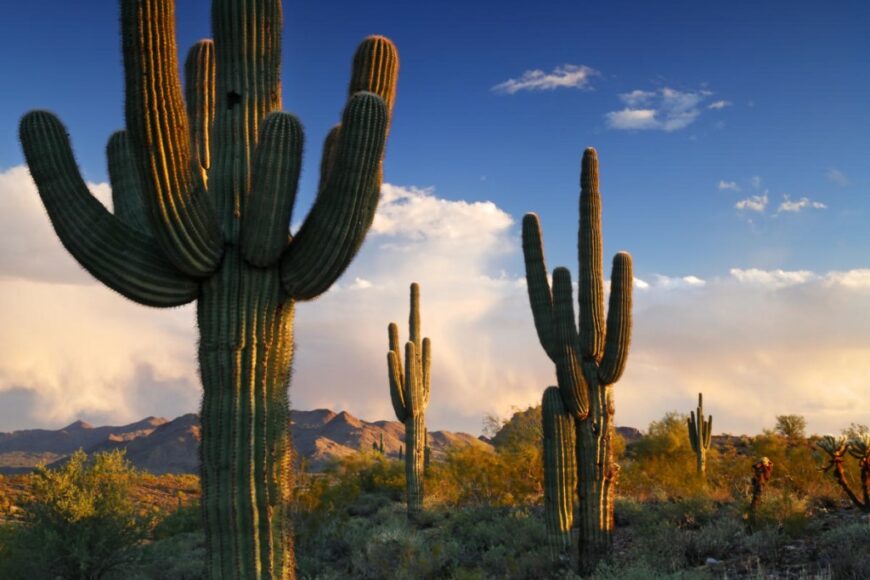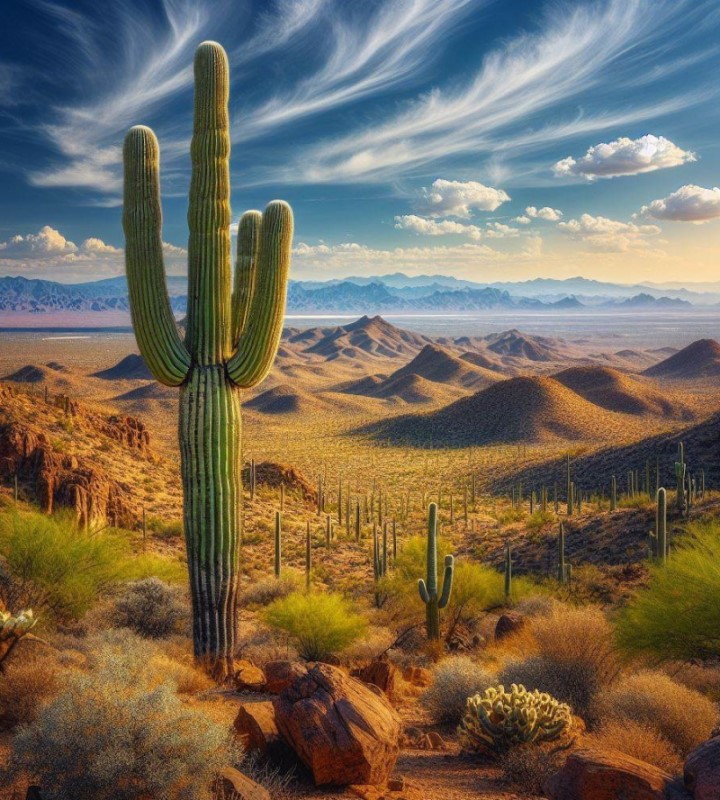
 Name: Carnegiea gigantea, Alternative names: Saguaro cactus, giant cactus, organ pipe cactus
Name: Carnegiea gigantea, Alternative names: Saguaro cactus, giant cactus, organ pipe cactus Family: Cactaceae
Family: Cactaceae Origins: Sonoran Desert, southwestern United States and northwestern Mexico
Origins: Sonoran Desert, southwestern United States and northwestern Mexico Humidity: Prefers low humidity
Humidity: Prefers low humidity Location: Full sun
Location: Full sun Soil: Well-drained, sandy or gravelly soil
Soil: Well-drained, sandy or gravelly soil Pests and diseases: Scales, mealybugs, fungal diseases
Pests and diseases: Scales, mealybugs, fungal diseases Care: Requires infrequent watering, especially during the winter months. Fertilize annually in the spring.
Care: Requires infrequent watering, especially during the winter months. Fertilize annually in the spring. Height of growth: Up to 75 feet tall
Height of growth: Up to 75 feet tall Planting in the soil: Choose a planting site that receives at least 6 hours of direct sunlight per day. Amend the soil with compost or other organic matter to improve drainage. Dig a planting hole that is twice as wide and deep as the root ball. Gently loosen the roots and spread them out in the hole. Fill the hole with soil and water thoroughly.
Planting in the soil: Choose a planting site that receives at least 6 hours of direct sunlight per day. Amend the soil with compost or other organic matter to improve drainage. Dig a planting hole that is twice as wide and deep as the root ball. Gently loosen the roots and spread them out in the hole. Fill the hole with soil and water thoroughly. Blooming: Blooms in the spring, producing white flowers with yellow throats.
Blooming: Blooms in the spring, producing white flowers with yellow throats.The desert landscapes of the southwestern United States are home to one of nature’s most iconic and majestic inhabitants – the Saguaro Cactus (Carnegiea gigantea). Towering over the arid terrain, these giants of the desert have not only adapted to extreme environmental conditions but have also played a crucial role in the ecosystems they inhabit. In this article, we’ll explore the taxonomy, growth, cultural significance, and ecological importance of the Saguaro Cactus, shedding light on both its natural wonders and the challenges it faces in a changing world.

The Saguaro Cactus stands as a symbol of resilience in the harsh conditions of the Sonoran Desert. With its towering stature and unique silhouette, the Saguaro has captured the fascination of botanists, ecologists, and admirers of the natural world. But beyond its striking appearance, what makes the Saguaro truly remarkable is its integral role in the delicate balance of desert ecosystems.
Content:
Taxonomy and Botanical Features
Scientifically classified as Carnegiea gigantea, the Saguaro belongs to the family Cactaceae. Its botanical features, including ribbed stems, protective spines, and a waxy skin, are adaptations to conserve water in the arid environments it calls home.
Natural Habitat
The Sonoran Desert, stretching across parts of Arizona, California, and Mexico, provides the ideal conditions for the Saguaro’s survival. The cactus’s ability to thrive in these extreme conditions is a testament to its evolutionary prowess and adaptability.
Growth and Development
Saguaros exhibit slow growth, with some individuals taking up to 75 years to reach maturity. The lifecycle of a Saguaro, from germination to towering adulthood, is a fascinating journey shaped by the challenges of the desert environment.
(Continue with the rest of the article, following the outlined headings and subheadings. Ensure a conversational style, engaging the reader with relevant details and anecdotes. Conclude the article by summarizing key points and emphasizing the importance of Saguaro conservation.)
Conclusion

In the vast expanses of the Sonoran Desert, the Carnegiea gigantea stands as a living testament to nature’s ability to adapt and thrive in seemingly inhospitable conditions. From its slow growth to the crucial role it plays in supporting wildlife and ecosystems, the Saguaro is not just a botanical wonder but a symbol of resilience and interconnectedness. As we marvel at these giants of the desert, it becomes our responsibility to ensure their continued existence by embracing sustainable practices and fostering a deeper understanding of their ecological and cultural significance.
FAQs about Saguaro Cactus
Can I grow a Saguaro Cactus in my garden?
While it’s possible to cultivate Saguaros in gardens, they require specific conditions, including well-draining soil and plenty of sunlight. Be mindful of local regulations, as some areas may have restrictions on growing native species.
Are Saguaros endangered?
While not currently listed as endangered, Saguaros face threats from habitat destruction and climate change. Conservation efforts are crucial to ensure their long-term survival.
Do Saguaros only grow in the United States?
Saguaros primarily inhabit the Sonoran Desert, which spans parts of the United States and Mexico. They are most commonly associated with the southwestern U.S.
How long does it take for a Saguaro to bloom?
Saguaros typically begin to bloom at around 35 years of age. The flowering season usually occurs in late spring to early summer.
What is the significance of the Saguaro in Native American cultures?
The Saguaro holds cultural significance for Native American communities, symbolizing endurance, strength, and the interconnectedness of all living things. It is often featured in ceremonies and traditional stories.
Where do saguaro cactus grow?
Saguaro cacti are native to the Sonoran Desert, which spans parts of Arizona, California, and Sonora, Mexico. They are found in arid regions with well-drained soil and plenty of sunlight.
How long does a saguaro cactus live?
Saguaro cacti can live for hundreds of years, with some specimens estimated to be over 200 years old. They grow very slowly, and a saguaro may only grow a few inches per year for its first 75 years.
Where are saguaro cactus found?
Saguaro cacti are found primarily in the Sonoran Desert, but they can also be found in smaller numbers in the Chihuahuan Desert and the Mohave Desert.
How old is a saguaro cactus when it grows arms?
Saguaro cacti typically do not start to grow arms until they are between 75 and 100 years old.
When do saguaro cactus bloom?
Saguaro cacti bloom in late spring or early summer. The flowers are large and fragrant, and they are a vital food source for many desert animals.
How do saguaro cactus reproduce?
Saguaro cacti reproduce through both sexual and asexual means. They can self-pollinate, and their seeds are spread by birds and other animals.
How to tell the age of a saguaro cactus?
The age of a saguaro cactus can be determined by counting the number of its ribs, which are the raised ridges on the cactus’s body. Each rib represents one year of growth.
How much does a saguaro cactus cost?
Saguaro cacti can be purchased from nurseries and online retailers. Prices vary depending on the size of the cactus and its age. A small saguaro cactus may cost as little as $50, while a large, mature cactus can cost several thousand dollars.
Where to buy saguaro cactus?
Saguaro cacti can be purchased from nurseries and online retailers. Some popular nurseries that sell saguaro cacti include:
– Arizona-Sonora Desert Museum
– Native Seed/SEARCH
– Desert Botanical Garden
Where to see saguaro cactus?
There are many places to see saguaro cacti in the wild. Some of the most popular locations include:
– Saguaro National Park
– Saguaro National Monument
– Organ Pipe Cactus National Monument
– Joshua Tree National Park
Why are saguaro cactus protected?
Saguaro cacti are protected by law because they are an important part of the Sonoran Desert ecosystem. They provide food and shelter for many animals, and they also help to regulate the desert’s climate.
What birds live in saguaro cactus?
Several species of birds nest in saguaro cacti, including:
– Gila woodpecker
– Cactus wren
– Gila Woodpecker
How to grow saguaro cactus from seed?
Saguaro cacti can be grown from seed, but it is a very difficult process. The seeds are very small and require very specific conditions to germinate. If you are interested in trying to grow a saguaro cactus from seed, it is best to consult with a horticulturist or expert on saguaro cactus cultivation.
What animals eat saguaro cactus?
Several animals eat saguaro cactus, including:
– Deer
– Javelina
– Saguaro moth
How to transplant a saguaro cactus?
Transplanting a saguaro cactus is a very delicate process. The cactus should only be transplanted when it is mature and has a large root system. The cactus should be carefully dug up and transported to its new location. It is important to water the cactus regularly and to provide it with shade until it has acclimated to its new surroundings.
How often do saguaro cactus bloom?
Saguaro cacti typically bloom only once a year. The flowers bloom for only a few days, and they are pollinated by bats.
How to grow a saguaro cactus indoors?
Saguaro cacti are not well-suited for indoor cultivation. They require very specific conditions, including bright sunlight, well-drained soil, and low humidity. If you are interested in growing a saguaro cactus indoors, it is best to consult with a horticulturist or expert on saguaro cactus cultivation.
How often to water saguaro cactus?
During the summer months (active growth), water once a month to every two weeks. During the winter months (dormant), water once every three to four weeks.
Additional notes ⚠️:
- Saguaro cacti are slow-growing plants, typically taking 50-75 years to reach maturity.
- They are an important part of the Sonoran Desert ecosystem, providing food and shelter for many animals.
- Saguaro cacti are protected by law in both the United States and Mexico.

